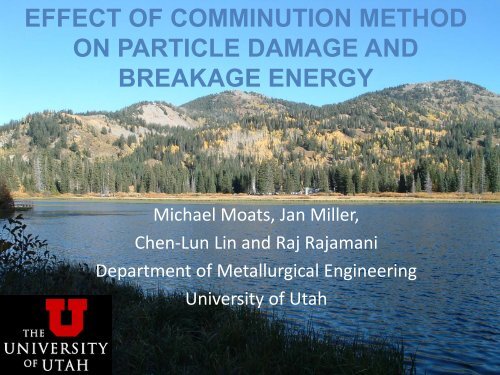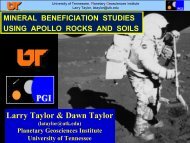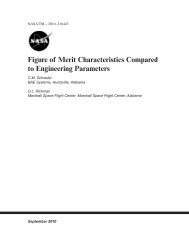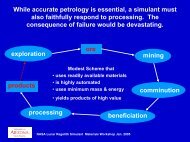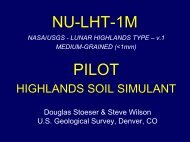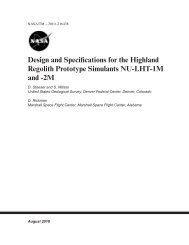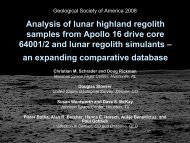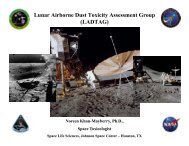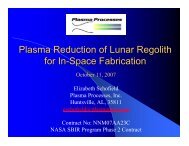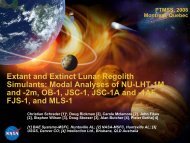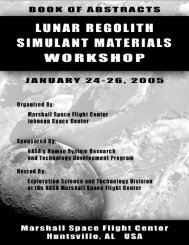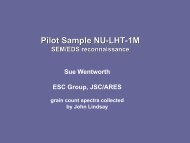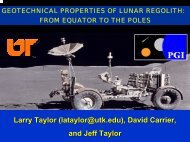effect of comminution method on particle damage and breakage
effect of comminution method on particle damage and breakage
effect of comminution method on particle damage and breakage
You also want an ePaper? Increase the reach of your titles
YUMPU automatically turns print PDFs into web optimized ePapers that Google loves.
EFFECT OF COMMINUTION METHODON PARTICLE DAMAGE ANDBREAKAGE ENERGYMichael Moats, Jan Miller,Chen-Lun Lin <strong>and</strong> Raj RajamaniDepartment <str<strong>on</strong>g>of</str<strong>on</strong>g> Metallurgical EngineeringUniversity <str<strong>on</strong>g>of</str<strong>on</strong>g> Utah
Outline• Our Department• High Pressure Grinding• Particle Damage Characterizati<strong>on</strong>• Breakage Energy• Applicati<strong>on</strong> to Simulant Development
Department <str<strong>on</strong>g>of</str<strong>on</strong>g>Metallurgical Engineering• University <str<strong>on</strong>g>of</str<strong>on</strong>g> Utah islocated in Salt Lake Cityal<strong>on</strong>g the Wasatch Mtns.• Only st<strong>and</strong> al<strong>on</strong>eMetallurgical Engineeringdepartment remaining inthe U.S.• Traditi<strong>on</strong>al curriculumwith critical mass <str<strong>on</strong>g>of</str<strong>on</strong>g>pr<str<strong>on</strong>g>of</str<strong>on</strong>g>essors– Mineral Processing– Chemical Metallurgy– Physical Metallurgy
High Pressure Grinding Rolls (HPGR) HPGR c<strong>on</strong>sists <str<strong>on</strong>g>of</str<strong>on</strong>g> a pair <str<strong>on</strong>g>of</str<strong>on</strong>g> counter rotating rolls, <strong>on</strong>e fixed <strong>and</strong> the other floating. The feed is introduced to the gap in between the rolls <strong>and</strong> they compress the bed <str<strong>on</strong>g>of</str<strong>on</strong>g> <strong>particle</strong>s.The grinding force applied to the crushing z<strong>on</strong>e is c<strong>on</strong>trolled by a hydro-pneumaticspring <strong>on</strong> the floating roll. Speeds <str<strong>on</strong>g>of</str<strong>on</strong>g> the rolls are also adjustable to obtain optimum grinding c<strong>on</strong>diti<strong>on</strong>s.
Comparis<strong>on</strong> <str<strong>on</strong>g>of</str<strong>on</strong>g> HPGR <strong>and</strong> AG/SAG MillsAspect HPGR AG/SAG MillGrinding Mechanism Inter-<strong>particle</strong> compressi<strong>on</strong> Impact, attriti<strong>on</strong> <strong>and</strong> compressi<strong>on</strong>Residence Time Low-single pass High (feed migrates through length<str<strong>on</strong>g>of</str<strong>on</strong>g> mill)Wet/Dry Grinding Dry-Low moisture Predominantly wet millingAvailability >90% -2-4 change outs pa >90% -1-2 change outs paSize regulated feed Required Yes-str<strong>on</strong>gly affects stud <strong>breakage</strong> AG-No, SAG-SometimesCritical material size Not required RequiredProduct <strong>particle</strong>micro-crackingYes (beneficial for downstreamprocessesNegligibleMaximum Throughput 2000tph 4000tphFootprint Small LargeSpecific power 1-5kWh/t 5-12kWh/tOperating cost Overall plant 20% lower Overall plant 20% higherCapital Cost 25% lower 25% higherDelivery time Substantially faster Substantially l<strong>on</strong>gerVariati<strong>on</strong> in feed hardness Single parameter variable High losses•Reference: Koenig, R.L. <strong>and</strong> Huds<strong>on</strong> J (2006). “Design Selecti<strong>on</strong> for Large-Scale Grinding Operati<strong>on</strong>s-AG/SAG or HPGR?”, Metallurgical Plant Design <strong>and</strong> OperatingStrategies (MetPlant 2006) 18-19 September 2006, Perth, WA.
HPGR vs. Jaw Crusher• Due to the scarcity <str<strong>on</strong>g>of</str<strong>on</strong>g> water <strong>on</strong> the lunar surface,dry <str<strong>on</strong>g>comminuti<strong>on</strong></str<strong>on</strong>g> will be performed.• HPGR are a likely c<strong>and</strong>idate for to crush <strong>and</strong> grindregolith material for use in c<strong>on</strong>structi<strong>on</strong> <strong>and</strong>oxygen generati<strong>on</strong>.• HPGR generate different product <strong>particle</strong>s thanc<strong>on</strong>venti<strong>on</strong>al crushing
Particle DamageCharacterizati<strong>on</strong> using XMTProjecti<strong>on</strong>3D ViewSliceViewsMiller <strong>and</strong> Lin, Mineral <strong>and</strong> Metallurgical Processing, 2004
XMT Images <str<strong>on</strong>g>of</str<strong>on</strong>g> Damage toOxide Copper Ore ParticlesJ.D. Miller. “Characterizati<strong>on</strong>, Analysis, <strong>and</strong> Simulati<strong>on</strong> <str<strong>on</strong>g>of</str<strong>on</strong>g> Multiphase Particulate Systems Using High Resoluti<strong>on</strong> X-ray MicroTomography (HRXMT)” XXV Internati<strong>on</strong>al Mineral Processing C<strong>on</strong>gress (IMPC 2010).
Percent <str<strong>on</strong>g>of</str<strong>on</strong>g> Damaged Particlesfor Different Crushing MethodsCrushingMethodExtent <str<strong>on</strong>g>of</str<strong>on</strong>g> Damage(% <str<strong>on</strong>g>of</str<strong>on</strong>g> Particles Cracked)Oxide CopperOreSulfide CopperOreFeed 14 20Jaw 14 23Low HPGR 37 51Medium HPGR 44 69High HPGR 79 84J.D. Miller. “Characterizati<strong>on</strong>, Analysis, <strong>and</strong> Simulati<strong>on</strong> <str<strong>on</strong>g>of</str<strong>on</strong>g> Multiphase Particulate Systems Using High Resoluti<strong>on</strong> X-ray MicroTomography (HRXMT)” XXV Internati<strong>on</strong>al Mineral Processing C<strong>on</strong>gress (IMPC 2010).
Isolati<strong>on</strong> <str<strong>on</strong>g>of</str<strong>on</strong>g> Crack Surfaces(Copper Ore , 1.70x0.85 mm)Miller <strong>and</strong> Lin, Recent Advances in Mineral Processing Plant Design, SME, p.48-59, 2009.
Isolati<strong>on</strong> <str<strong>on</strong>g>of</str<strong>on</strong>g> Crack Surfaces(Copper Ore , 1.70x0.85 mm)Miller <strong>and</strong> Lin, Recent Advances in Mineral Processing Plant Design, SME, p.48-59, 2009.
Preliminary Crack Informati<strong>on</strong> forDamaged Particle <str<strong>on</strong>g>of</str<strong>on</strong>g> Copper OreParticleVolume(mm 3 )Total SurfaceArea <str<strong>on</strong>g>of</str<strong>on</strong>g> Cracks(mm 2 )Specific cracksurface area(mm 2 /mm 3 )0.28 2.8 10
HPGR vs. Jaw CrusherJAW Crusher ProductHPGR ProductThe dark areas highlight internal cracks, internal pores, <strong>and</strong>crack surfaces.Lin <strong>and</strong> Miller. SME 2010 Annual Meeting
Particle Breakage Energy• Ultra Fast Load Cell (UFLC)UFLC is a device supported byelectrical equipments to measurethe fracture energy <str<strong>on</strong>g>of</str<strong>on</strong>g> any <strong>particle</strong>at first fracture under impactloading.A steel rod <str<strong>on</strong>g>of</str<strong>on</strong>g> 5 m length isequipped with strain gauges tocatch very high resoluti<strong>on</strong> signalsat the instant <str<strong>on</strong>g>of</str<strong>on</strong>g> fracture.LasersourceStrain gaugesDrop weightrelease systemCollecti<strong>on</strong> boxPhotodiodeData acquisiti<strong>on</strong>boardComputerFracture happens in 100 microsec<strong>on</strong>dstime rangeSignalc<strong>on</strong>diti<strong>on</strong>erT.Tuzcu, R.Rajamani (2010) “Modeling <strong>breakage</strong> rates in mills with impact energy spectra <strong>and</strong> ultra fast loadcell data” Minerals Engineering, doi:10.1016/j.mineng.2010.08.017.
Informati<strong>on</strong> from UFLC• UFLC captures high-resoluti<strong>on</strong> compressive force signals.• It provides detailed informati<strong>on</strong> about fracturecharacteristics <str<strong>on</strong>g>of</str<strong>on</strong>g> the <strong>particle</strong> under impact loading.• The measurement <str<strong>on</strong>g>of</str<strong>on</strong>g> the compressive force at the instant<str<strong>on</strong>g>of</str<strong>on</strong>g> fracture <str<strong>on</strong>g>of</str<strong>on</strong>g> the <strong>particle</strong> allows computati<strong>on</strong> <str<strong>on</strong>g>of</str<strong>on</strong>g> tensilestrength <strong>and</strong> stiffness <str<strong>on</strong>g>of</str<strong>on</strong>g> the <strong>particle</strong>, energy at firstfracture, the energy stored by the <strong>particle</strong> <strong>and</strong> the residualenergy <str<strong>on</strong>g>of</str<strong>on</strong>g> the falling object after breaking the <strong>particle</strong>.• By testing 30 or so <strong>particle</strong>s <strong>on</strong>e can get fractureprobability distributi<strong>on</strong>.L.M. Tavares <strong>and</strong> R.P. King, Modeling <str<strong>on</strong>g>of</str<strong>on</strong>g> <strong>particle</strong> fracture by repeated impacts using c<strong>on</strong>tinuum<strong>damage</strong> mechanics, Powder Technology 123 (2002) 138–146.
Breakage SignatureStrain signals are captured at themoment <str<strong>on</strong>g>of</str<strong>on</strong>g> fracture as voltage vs.time pr<str<strong>on</strong>g>of</str<strong>on</strong>g>ileT. Tuzcu, PhD Dissertati<strong>on</strong>, Univ. Of Utah, 2009
Force – Time Pr<str<strong>on</strong>g>of</str<strong>on</strong>g>ileVoltage-time pr<str<strong>on</strong>g>of</str<strong>on</strong>g>ileis then c<strong>on</strong>vertedinto force-timepr<str<strong>on</strong>g>of</str<strong>on</strong>g>ile. Graph showsa 2.88 cm steelsphere striking the5.2 m rod.T. Tuzcu, PhD Dissertati<strong>on</strong>, Univ. Of Utah, 2010
Probability <str<strong>on</strong>g>of</str<strong>on</strong>g> FractureParticles exhibit different fractureenergy due to their r<strong>and</strong>om internalflaw size distributi<strong>on</strong>. Graph showsthe probability <str<strong>on</strong>g>of</str<strong>on</strong>g> fracture <str<strong>on</strong>g>of</str<strong>on</strong>g> a<strong>particle</strong> at a specified energy. Then, itcan be decided whether a <strong>particle</strong>will break or not under a particularloading.The probability <str<strong>on</strong>g>of</str<strong>on</strong>g> <strong>breakage</strong> alsodepends <strong>on</strong> the <strong>damage</strong> state <str<strong>on</strong>g>of</str<strong>on</strong>g>the <strong>particle</strong>. Our researchprogram can integrate informati<strong>on</strong>from XMT <strong>and</strong> UFLC to improveour underst<strong>and</strong>ing <str<strong>on</strong>g>of</str<strong>on</strong>g> <strong>particle</strong><strong>breakage</strong> phenomena.T. Tuzcu, PhD Dissertati<strong>on</strong>, Univ. Of Utah, 2010
Applicati<strong>on</strong> to SimulantDevelopment• Comminuti<strong>on</strong> <str<strong>on</strong>g>method</str<strong>on</strong>g>s affect simulant <strong>particle</strong>s– Particle size <strong>and</strong> shape– Internal defects– Energy c<strong>on</strong>sumpti<strong>on</strong> for subsequent <strong>breakage</strong>• Internal characterizati<strong>on</strong> <str<strong>on</strong>g>of</str<strong>on</strong>g> lunar regolith <strong>and</strong> simulantwould strength underst<strong>and</strong> <str<strong>on</strong>g>of</str<strong>on</strong>g> the materials– Internal crack/<strong>damage</strong> specificati<strong>on</strong> would be desirable toinsure better simulant• Breakage signature is another way to characterizesimulant <strong>and</strong> evaluate energy needed for <str<strong>on</strong>g>comminuti<strong>on</strong></str<strong>on</strong>g><strong>on</strong> the lunar surface
Thank You for Your Attenti<strong>on</strong>Questi<strong>on</strong>s?


